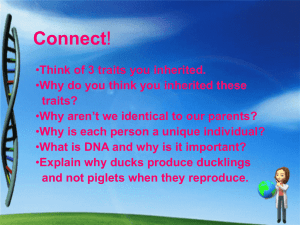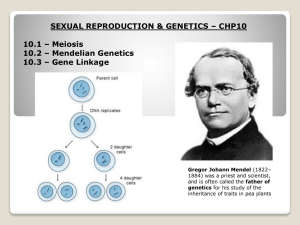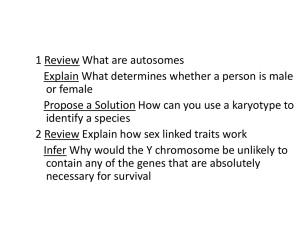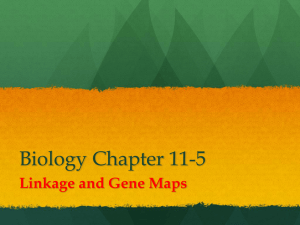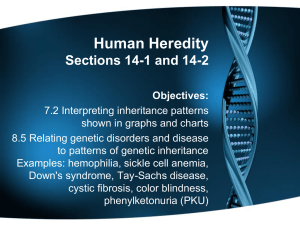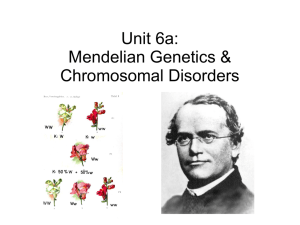Chapter 15 Study Guide
advertisement
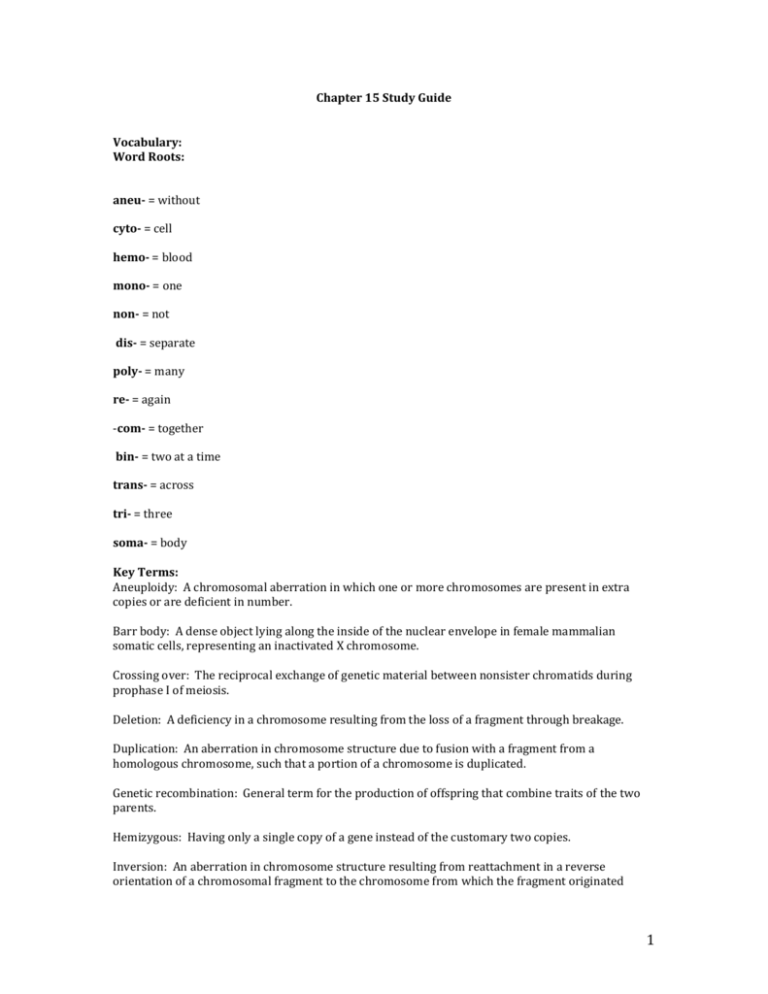
Chapter 15 Study Guide Vocabulary: Word Roots: aneu- = without cyto- = cell hemo- = blood mono- = one non- = not dis- = separate poly- = many re- = again -com- = together bin- = two at a time trans- = across tri- = three soma- = body Key Terms: Aneuploidy: A chromosomal aberration in which one or more chromosomes are present in extra copies or are deficient in number. Barr body: A dense object lying along the inside of the nuclear envelope in female mammalian somatic cells, representing an inactivated X chromosome. Crossing over: The reciprocal exchange of genetic material between nonsister chromatids during prophase I of meiosis. Deletion: A deficiency in a chromosome resulting from the loss of a fragment through breakage. Duplication: An aberration in chromosome structure due to fusion with a fragment from a homologous chromosome, such that a portion of a chromosome is duplicated. Genetic recombination: General term for the production of offspring that combine traits of the two parents. Hemizygous: Having only a single copy of a gene instead of the customary two copies. Inversion: An aberration in chromosome structure resulting from reattachment in a reverse orientation of a chromosomal fragment to the chromosome from which the fragment originated 1 Linked genes: Genes located close enough together on a chromosome to be usually inherited together Monosomic: Referring to a cell that has only one copy of a particular chromosome, instead of the normal two. Mosaic: A person or a tissue that contains two or more types of genetically different cells. Nondisjunction: An error in meiosis or mitosis, in which both members of a pair of homologous chromosomes or both sister chromatids fail to move apart properly. Parental type: An offspring with a phenotype that matches one of the parental phenotypes. Polyploidy: A chromosomal alteration in which the organism possesses more than two complete chromosome sets. Recombinant: An offspring whose phenotype differs from that of the parents; also called recombinant type. Sex-linked gene: A gene located on a sex chromosome. Translocation: An aberration in chromosome structure resulting from attachment of a chromosomal fragment to a nonhomologous chromosome. Trisomic: Referring to a cell that has three copies of a particular chromosome, instead of the normal two. Wild type: An individual with the normal (most common) phenotype. X-linked: A gene located on the X chromosome. Chapter 15 Important Points: The Chromosomal Theory of Inheritance is important because it addresses the fact that genes have specific, predicted locations (loci) on chromosomes and that it is the whole chromosome that is segregated during meiosis, not individual genes o This allows for some genes to be linked together in their inheritance patterns Wild type refers to the phenotype typically seen by most individuals for a particular character Sex Chromosomes: Sex in mammals in determined by which combination of sex chromosomes an individual possesses o Human females have 2 X chromosomes (and therefore have 23 pairs of homologous chromosomes) o Human males have 1 X and 1 Y chromosome and therefore have 22 pairs of autosomal homologous chromosomes but their sex chromosomes are not homologous (meaning the X and Y gene do not carry the same gene loci) The SRY gene on the Y chromosome (which contains far fewer genes overall compared to the X) codes for proteins that determine the male characteristics Any individual who has a Y chromosome is therefore chromosomally “male” X linked genes are only found on the X chromosome and females will have 2 copies Females can be homozygous or heterozygous for X linked genes 2 Females give their X linked genes to both daughters and sons Males will have 1 copy of X-linked genes Males can not be homozygous or heterozygous (therefore can not be carriers) for X linked genes but can be hemizygous Males only give their X linked genes to their daughters X-linked recessive diseases are more common in males than females During development in female mammalian somatic cells, one of the 2 X chromosomes becomes a Barr body and is deactivated Genes on the Barr body are not expressed Deactivation is random for each cell so adult somatic cells could be a mosaic if a female was a heterozygote for an X-linked gene One functional X chromosome is required so normal human males will not have any Barr bodies o Linked Genes: When genes are not linked (therefore on different pairs of chromosomes), they undergo independent assortment and we expect equal probabilities of gametes that will create parental and recombinant phenotypes If genes are linked, we would expect 100% parental phenotypes but that is not always the case o Crossing over between non-sister chromatids during Prophase I of Meiosis I can create recombinant chromosomes A recombination frequency is the percentage of recombinant offspring out of all offspring o Recombination frequency of 50% tells us 2 genes are either on completely different chromosomes (and thus independent assortment applies) OR so far apart on the same chromosome so that crossing over occurs 100% of the time between the 2 genes o Any recombination frequency less than 50% implies 2 genes are linked Chromosomal Errors: Non-disjunction occurs when homologous chromosomes in anaphase I meiosis I or sister chromatids in mitosis or anaphase II of meiosis II fail to properly separate o This causes incorrect chromosome numbers in the resulting daughter cells (aneuploidy) o For meiosis, if aneuploid cells are used for fertilization, it will create zygotes that are potentially monsomic, 2n-1, (have one fewer chromosome than normal with one pair of homologous chromosomes lacking a partner) or trisomic, 2n+1, (having 3 chromosomes for a given pair) o Polyploidy refers to having extra entire sets of chromosomes o Aneuploidy in humans often results in miscarriage or severe defects often causing early death o Monosomy in humans is lethal except for the X chromosome (see below) A common human condition caused by non-disjunction is Down Syndrome in which an individual has 3 copies (trisomy, 2n+1) for chromosome #21 o Most frequently caused by older maternal age but all ages of mothers can have a Down baby Non-disjunction of the sex chromosomes results in a viable offspring but with various phenotypic effects (except for males missing the X—OY which is nonviable) o Monosomy for the X chromosome in human females causes Turner’s Syndrome (XO) which causes sterility and other issues o An extra X in human males is XXY and causes Kleinfelter Syndrome; individuals are male but sterile and have feminized characteristics Chromosome structure can also be altered by mistakes during crossing over o Many genes are typically involved in these types of errors often leading to significant phenotypic effects 3 Deletion: Missing chromosomal segments Duplication: Segments of chromosomes are improperly duplicated Inversion: Segments are present but in reverse order Translocation: Segments of chromosomes are not found on the correct chromosome but attached to other pairs of homologous chromosomes 4

